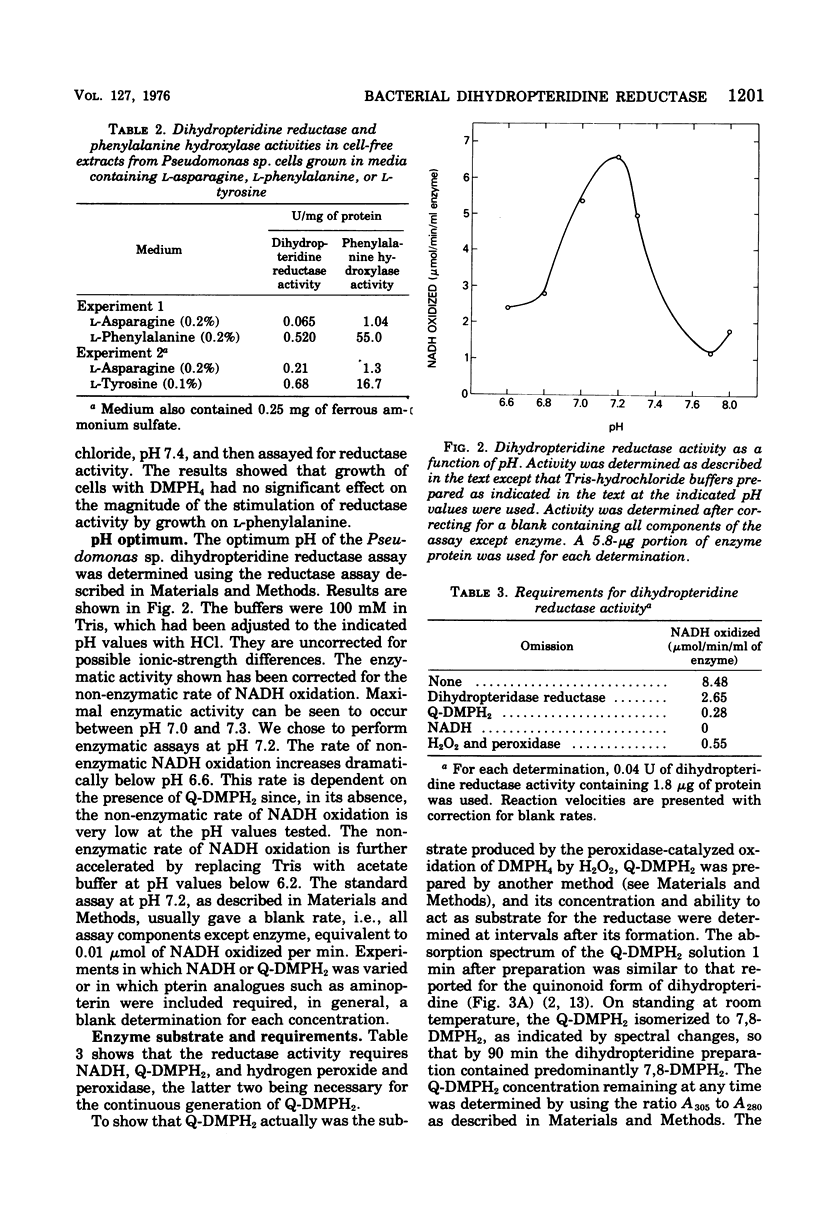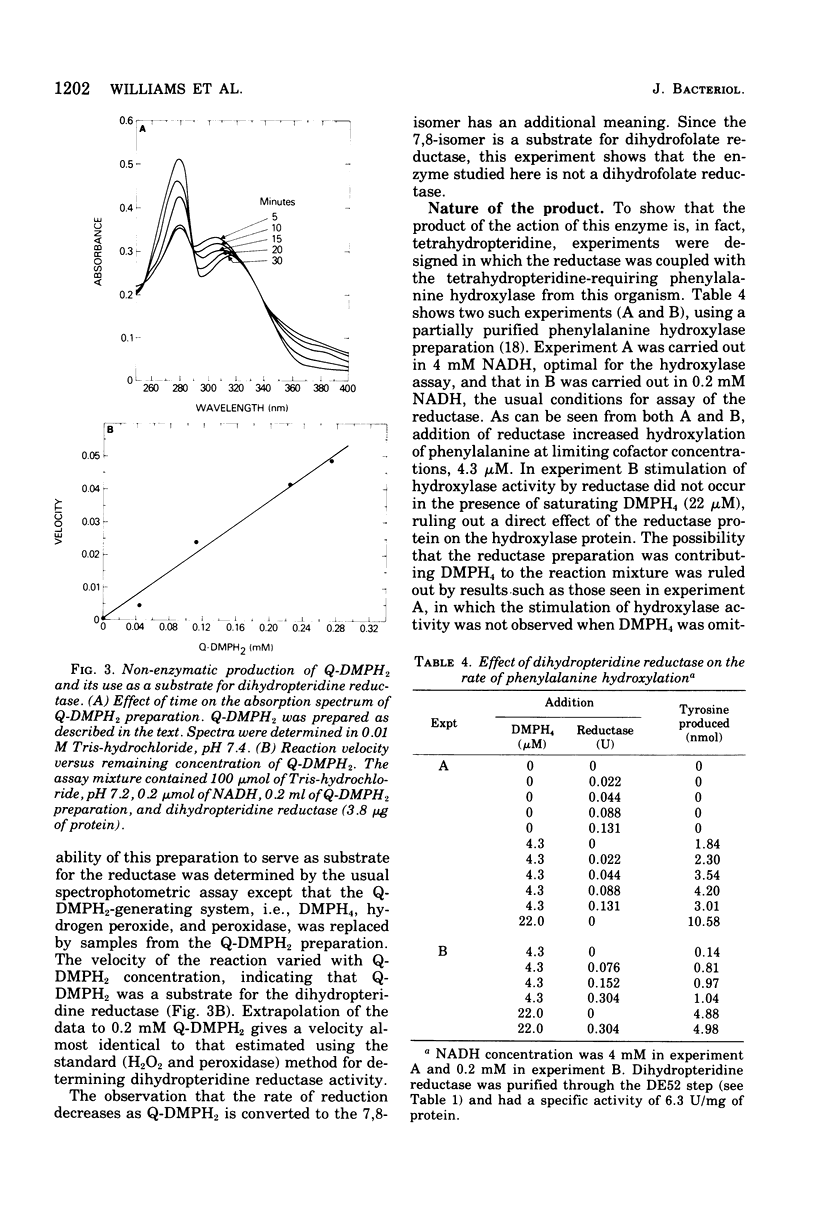Abstract
Dihydropteridine reductase isolated from the bacterium Pseudomonas species (ATCC 11299a) has been purified approximately 450-fold byammonium sulfate precipitation and diethylaminoethyl-cellulose chromatographic procedures. The preparation is at least 80% pure as judged by polyacrylamide gels. Its molecular weight was determined to be about 44,000. Both dihydropteridine reductase and phenylalanine hydroxylase activities were found to be higher in cells adapted to a medium containing L-phenylalanine or L-tyrosine as the sole carbon source than in those grown in L-asparagine. The substrate of the reductase is quinonoid dihydropteridine, and the product is tentatively identified as a tetrahydropteridine through its ability to serve as a cofactor for phenylalanine hydroxylase. The enzyme shows no marked specificity for the pteridine cofactor that occurs naturally in this organism, L-threo-neopterin. The pH optimum for the reductase is 7.2, and nicotinamide adenine dinucleotide, reduced form, is the preferred cosubstrate. Inhibition of the reduced and untreated enzyme by several sulfhydryl reagents was observed. A metal requirement for the reductase could not be demonstrated. Dihydropteridine reductase was found to be inhibited by aminopterin in a competitive manner with respect to the quinonoid dihydro form of 2-amino-4-hydroxy-6,7-dimethyl-5,6,7,8-tetrahydropteridine.
Full text
PDF










Selected References
These references are in PubMed. This may not be the complete list of references from this article.
- Abita J. P., Dorche C., Kaufman S. Futher studies on the nature of phenylalanine hydroxylation in brain. Pediatr Res. 1974 Jul;8(7):714–717. doi: 10.1203/00006450-197407000-00005. [DOI] [PubMed] [Google Scholar]
- Archer M. C., Scrimgeour K. G. Rearrangement of quinonoid dihydropteridines to 7,8-dihydropteridines. Can J Biochem. 1970 Mar;48(3):278–287. doi: 10.1139/o70-049. [DOI] [PubMed] [Google Scholar]
- Cheema S., Soldin S. J., Knapp A., Hofmann K. T., Scrimgeour K. G. Properties of purifed quinonoid dihydropterin reductase. Can J Biochem. 1973 Sep;51(9):1229–1239. doi: 10.1139/o73-163. [DOI] [PubMed] [Google Scholar]
- Craine J. E., Hall E. S., Kaufman S. The isolation and characterization of dihydropteridine reductase from sheep liver. J Biol Chem. 1972 Oct 10;247(19):6082–6091. [PubMed] [Google Scholar]
- DIXON M. The determination of enzyme inhibitor constants. Biochem J. 1953 Aug;55(1):170–171. doi: 10.1042/bj0550170. [DOI] [PMC free article] [PubMed] [Google Scholar]
- GUROFF G., ITO T. PHENYLALANINE HYDROXYLATION BY PSEUDOMONAS SPECIES (ATCC 11299A). J Biol Chem. 1965 Mar;240:1174–1184. [PubMed] [Google Scholar]
- Guroff G., Abramowitz A. A simple radioisotope assay for phenylalanine hydroxylase. Anal Biochem. 1967 Jun;19(3):548–555. doi: 10.1016/0003-2697(67)90245-x. [DOI] [PubMed] [Google Scholar]
- Guroff G., Rhoads C. A. Phenylalanine hydroxylation by Pseudomonas species (ATCC 11299a). Nature of the cofactor. J Biol Chem. 1969 Jan 10;244(1):142–146. [PubMed] [Google Scholar]
- KAUFMAN S. Studies on the mechanism of the enzymatic conversion of phenylalanine to tyrosine. J Biol Chem. 1959 Oct;234:2677–2682. [PubMed] [Google Scholar]
- KAUFMAN S. The enzymatic conversion of phenylalanine to tyrosine. J Biol Chem. 1957 May;226(1):511–524. [PubMed] [Google Scholar]
- KAUFMAN S. The nature of the primary oxidation product formed from tetrahydropteridines during phenylalanine hydroxylation. J Biol Chem. 1961 Mar;236:804–810. [PubMed] [Google Scholar]
- Kaufman S. The phenylalanine hydroxylating system from mammalian liver. Adv Enzymol Relat Areas Mol Biol. 1971;35:245–319. doi: 10.1002/9780470122808.ch6. [DOI] [PubMed] [Google Scholar]
- LOWRY O. H., ROSEBROUGH N. J., FARR A. L., RANDALL R. J. Protein measurement with the Folin phenol reagent. J Biol Chem. 1951 Nov;193(1):265–275. [PubMed] [Google Scholar]
- Letendre C. H., Dickens G., Guroff G. Phenylalanine hydroxylase from Pseudomonas sp. (ATCC 11299a). Purification, molecular weight, and influence of tyrosine metabolites on activation and hydroxylation. J Biol Chem. 1975 Sep 10;250(17):6672–6678. [PubMed] [Google Scholar]
- Letendre C. H., Dickens G., Guroff G. The tryptophan hydroxylase of Chromobacterium violaceum. J Biol Chem. 1974 Nov 25;249(22):7186–7191. [PubMed] [Google Scholar]
- Lind K. E. Dihydropteridine reductase. Measurement of dissociation constants for binary complexes of enzyme and ligands. Eur J Biochem. 1973 Feb 15;33(1):67–70. doi: 10.1111/j.1432-1033.1973.tb02655.x. [DOI] [PubMed] [Google Scholar]
- Musacchio J. M. Beef adrenal medulla dihydropteridine reductase. Biochim Biophys Acta. 1969 Nov 4;191(2):485–487. doi: 10.1016/0005-2744(69)90272-1. [DOI] [PubMed] [Google Scholar]
- Musacchio J. M., D'Angelo G. L., McQueen C. A. Dihydropteridine reductase: implication on the regulation of catecholamine biosynthesis. Proc Natl Acad Sci U S A. 1971 Sep;68(9):2087–2091. doi: 10.1073/pnas.68.9.2087. [DOI] [PMC free article] [PubMed] [Google Scholar]
- Nielsen K. H., Simonsen V., Lind K. E. Dihydropteridine reductase. A method for the measurement of activity, and investigations of the specificity for NADH and NADPH. Eur J Biochem. 1969 Jul;9(4):497–502. doi: 10.1111/j.1432-1033.1969.tb00636.x. [DOI] [PubMed] [Google Scholar]
- Osanai M., Rembold H. Cofactor specificity of L-erythro-tetrahydrobiopterin for rat liver phenylalanine 4-hydroxylase. Hoppe Seylers Z Physiol Chem. 1971 Oct;352(10):1359–1362. doi: 10.1515/bchm2.1971.352.2.1359. [DOI] [PubMed] [Google Scholar]
- WILKINSON G. N. Statistical estimations in enzyme kinetics. Biochem J. 1961 Aug;80:324–332. doi: 10.1042/bj0800324. [DOI] [PMC free article] [PubMed] [Google Scholar]
- Woolf L. I., Jakubovic A., Chan-Henry E. The non-enzymic hydroxylation of phenylalanine to tyrosine by 2-amino-4-hydroxy-6,7-dimethyl-5,6,7,8-tetrahydropteridine. Biochem J. 1971 Nov;125(2):569–574. doi: 10.1042/bj1250569. [DOI] [PMC free article] [PubMed] [Google Scholar]


